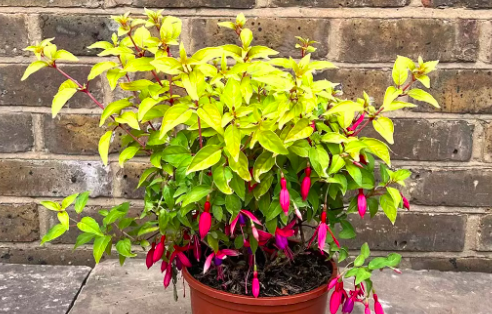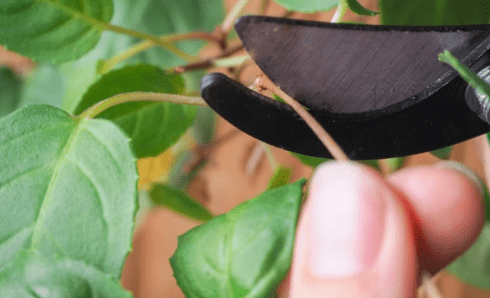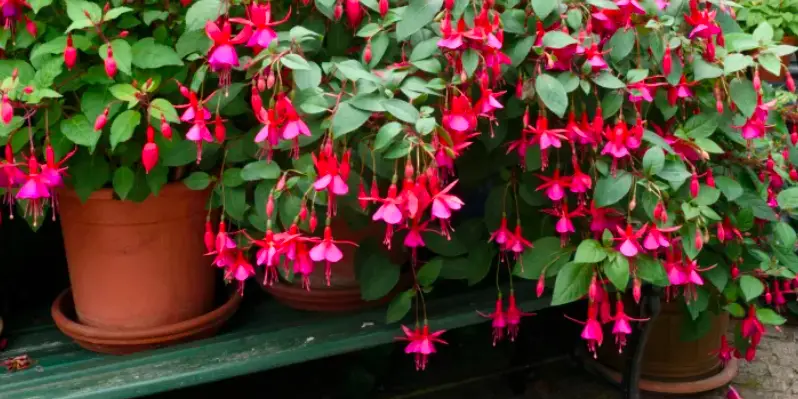Do you have a fuchsia plant that you love, but don’t know how to keep it alive during the winter? Fuchsias can be overwintered indoors or outdoors, depending on where you live. In this blog post, we will discuss the best ways to overwinter your fuchsia plant so that it stays healthy and blooms all winter long!
Can Potted Fuchsias Be Overwintered?
Yes, fuchsia can be overwintered! This process involves putting fuchsias into a dormancy stage so that they can rest and recuperate during the winter months. When done correctly, overwintering fuchsias can help them live for years to come! Tender fuchsias will usually need to be overwintered indoors, depending on your location and climate.
The goal of overwintering is to put the fuchsia into dormancy, so it’s important to allow the plant to go through its natural process. Your fuchsia will not bloom during this process, but that’s okay! The plant is resting and preparing for the next blooming season.

How to Overwinter Potted Fuchsias?
There are two main types of fuchsias- hardy and tender. Hardy fuchsias can withstand cold temperatures and do not need to be brought indoors for the winter. Tender fuchsias, on the other hand, cannot withstand cold temperatures and must be brought indoors for the winter.
As your fuchsia is in a pot, you likely own a tender fuchsia. This means that you will need to bring your fuchsia plant indoors for the winter so that it does not die in the cold weather. The inside temperature shouldn’t be warm, but it should be at least 40-45°F and free of drafts. A garage is ideal as it also provides low-light conditions, which is perfect for fuchsias during their dormancy period.
Here’s my five-step process for overwintering potted fuchsias:
Step One: Start decreasing the amount of water you give your fuchsia plant about a month before you plan on overwintering it. This will be done in the latter autumn months when the days are getting shorter and the temperature is gradually decreasing.
Step Two: Once the weather has cooled down and there is a risk of frost, bring your fuchsia inside into a frost-free area, like a garage, shed, or greenhouse.
Step Three: Cut back the fuchsia plant so that no leaves remain on the plant. This will help the plant to conserve its energy during the winter months.

Step Four: Once your fuchsia is inside, add water sparingly. You should only water your fuchsia plant when the soil is completely dry, which will be roughly once per month.
Step Five: When spring arrives, repot your fuchsia plant into fresh potting soil and start increasing the amount of water you give it. Once the risk of frost has passed, you can also put your fuchsia plant back outside.
Watch Out For…
When bringing fuchsias inside, watch out for pests that may have hitched a ride on the plant. These include whiteflies, aphids, and mealybugs. If you see any of these pests, be sure to remove them from your plant immediately so that they don’t spread to other plants in your home.
Neem oil is a great natural solution for getting rid of pests on plants. Simply mix neem oil with water according to the directions on the bottle, and then spray your fuchsia plant with the mixture. Be sure to do this in a well-ventilated area as neem oil can be quite pungent!
Fungus should also be kept an eye out for as it can spread quickly in humid conditions. If you see any signs of fungus, such as powdery mildew or black spots on the leaves, be sure to remove the affected leaves and increase the amount of airflow around your plant.
Again, neem oil can be used to treat fungus in plants. It is a natural fungicide that will help to get rid of the fungus without harming your plant. To stop fungus from coming back, make sure to keep the area around your fuchsia plant clean and free of debris.
Bringing Fuchsias Out of Hibernation
When spring arrives, it’s time to start bringing your fuchsia plant out of hibernation. Start by repotting your fuchsia plant into fresh potting soil and increasing the amount of water you give it.
Find a sunny spot in your garden or home and slowly start acclimating your fuchsia plant to warmer temperatures and more light. Once the risk of frost has passed, you can put your fuchsia plant outside in its permanent location.
This is also the perfect time to trim branches halfway to encourage bushier growth. Fertilize your fuchsia plant once per month with a balanced fertilizer to help it recover from its time in dormancy and encourage healthy growth.
Conclusion
In conclusion, overwintering your fuchsia plant is a great way to keep it healthy and blooming all winter long! Be sure to follow the steps outlined in this blog post so that you can successfully overwinter your own potted fuchsia plant.
Remember, bringing your fuchsia plant inside for the winter is essential if you want it to survive the cold weather. Once spring arrives, you can repot your fuchsia plant into fresh potting soil and start increasing the amount of water you give it. With a little bit of care, your fuchsia plant will be blooming all summer long!
I hope this blog post was helpful in teaching you how to overwinter your fuchsia plant! If you have any questions, feel free to leave a comment below and I’ll be happy to help. Thanks for reading!
Tim is an avid gardener from the UK. He was the founder of PlantCarer.com from 2021 to Sep 2023. He sold PlantCarer.com to Aaron. He has since started his own business called Seed To Supper, which provides new gardeners all the materials you need in a box (pots, seeds, compost and instructions) to grow your own delicious and nutritious vegetables and herbs from start to finish – no garden required.

